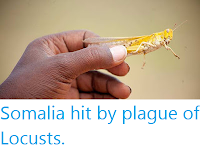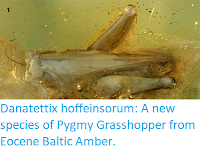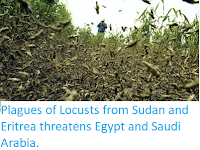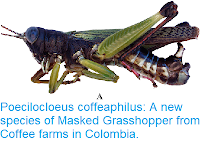The Food and Agriulture Organisation's Locust Watch Program has issued a warning that several new Desert Locust, Schistocerca gregaria, swarms are emerging in northern Kenya, southern Ethiopia, Somalia and Yemen, threatening further food insecurity in the region. The area has already been suffering the worst Locust outbreak in 70 years, leading to the destruction of crops across Ethiopia, Somalia, Kenya, Djibouti, Eritrea, Tanzania, Sudan, South Sudan, Uganda, Yemen, Oman and Saudi Arabia, but the agency has warned that the Insects are breeding rapidly in remote areas where there is little oportunity for aerial spraying, the most effective way of controlling them, and that populations emerging now would be likely to swarm in June, which is peak crop growing time in the region.
Desert Locusts typically have two or three generations
in a year, but when conditions are favourable then five or more
generations can occur. The females lay eggs in an ootheca (egg sack) in
soft sand, where they can remain dormant until conditions are favourable
or hatch within a few days. Hatchlings can reach maturity in about five
weeks, eating as much as one-and-a-half times their body weight each
day, when they are potentially able to breed again.
The adult form of the Desert Locust has two forms, the
more usual solitary form, which does not usually move far from the area
where they emerge, and a gregarious form, which forms large swarms and
can roam long distances. The change from solitary to gregarious Locusts
can happen in individuals, which change from one to the other in
response to a rise in population density, but the reverse, a change from
gregarious to solitary Locusts, can only happen when a new generation
reaches maturity.
Solitary (top) and gregarious (bottom) Desert Locust nymphs. Compton Tucker/NASA/Goddard Space Flight Center/Wikimedia Commons.
See also...
Follow Sciency Thoughts on
Facebook.









